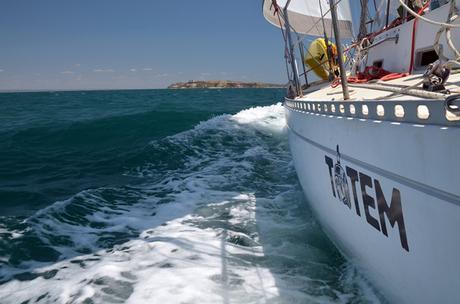
Ocean currents have been a significant factor for our Indian Ocean passages this year, and our upcoming passage to South Africa is no exception. On this morning’s SSB net, one boat after another chimed in about the strong foul current they’re experiencing off the Madagascar coast as they head towards South Africa. Most entered the Mozambique channel at a point off the western ‘bulge’ called Cap Saint Andre. It’s 220 miles east of the Mozambique coastline, making it shortest point between Madagascar and Africa. One of the first boats reporting by SSB described two to three knots of foul current overnight – another said they had to start motoring because the current had them sailing backwards!
Why fight it? In choosing a channel crossing strategy, Cap Saint Andre looks good because of the shorter distance to getting coastal again. Winds tend to be light, but there is little chance of getting wacked by big weather – at least until the final approach to South Africa. Advice was passed around, written by cruisers that have done this crossing 7 times with preference of heading west from Cap Saint Andre until turning southward some 70 miles from Mozambique with the south flowing Agulhas current.
It’s a conservative strategy that makes sense – except when the very dynamic Mozambique channel currents become strong from the wrong direction, just as the group of boats that set out westward over the past few days are now reporting. Unfortunately for them, this strong, foul current was showing on the current models when they departed, and will continue for more days to come. That short 220 miles is probably feeling like 500 about now.
For all accounts, these former cruisers incredibly helpful and giving folks who share a wealth of valuable knowledge with boats in the region. But this is a good example of a couple of things: first, that “local knowledge” from past experiences doesn’t always work with here and now situations. It’s easy to fall into a routing strategy and then put the blinders on. Second, that it’s a really good idea to back up any advice with your own research. The advice may have been great previously, but it’s not working for the boats out there right now!
Routing for many passages is easy – watch the weather and go when good. This stretch of ocean takes more. Southern Africa is a weather machine: Atlantic and Indian Oceans colliding, hot winds from the Namibia desert and cold winds from the Southern Ocean, and the freight train of hot water called the Agulhas current. It’s this south flowing current that can build mountainous, ship smashing waves when pushed up by strong southerly winds. In the stretch of the Mozambique channel we’re facing, winds are lighter and the Agulhas current not yet a full strength, but there is there is enough water flow to keep changing the patterns. It’s not enough to look at just wind velocity and direction.
There are a few options for getting ocean current data. These three are accessible through internet during pre-passage planning or a satellite and HF radio connection underway.
PredictWind Offshore Routing
Our primary tool to make the best use of (or avoid) currents is with the routing optimization in PredictWind’s Offshore app, which uses the OSCAR current model.
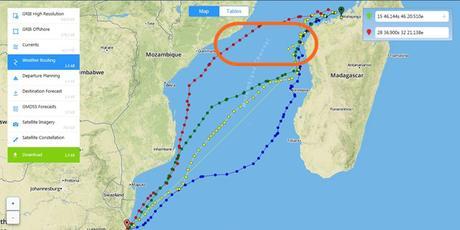
Plugging in routing closest to what these boats have done- leaving from around Mahajanga, destination Richards Bay – all four models (each based on a different wind GRIB, but the same current model) avoid this area of foul current. This routing took about a minute to download on our Iridium GO! this morning.
PredictWind has done the heavy lifting by baking wind and current information into four recommended routes, each route based on a different source model GRIB. Smart users will look at the factors behind the split in these models, and then make their own decision. It’s also a good idea to update the route underway as changing weather forecasts may revise the optimal route.
Efficient routing can shave not just hours, but DAYS off a crossing. With the nasty weather systems that roll up from the south in this area, a fast crossing is a safe crossing.
RTOFS model Saildocs query
HF radio users can use the GRIB request screen in Airmail to get RTOFS models through the catalog.
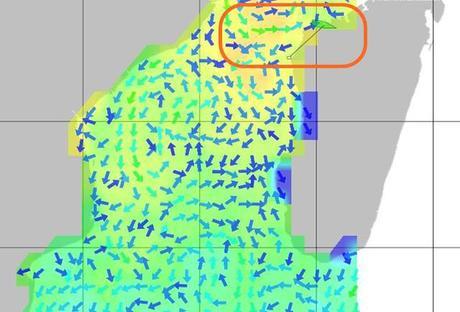
Just go to the GRIB area map, choose RTOFS from the multi-select dropdown labeled ‘Model’ at the bottom left corner, and then select your area from the map.
OSCAR model from SV Sarana
Eric & Sherrell are long time cruisers and data nerds (this is an accolade!) who have created a set of tools to convert the massive ocean current simulation data from NASA-funded Ocean Surface Currents in Real-Time (OSCAR) into bite-size files that can be accessed via email. It’s been around for a couple of years, but we only found about it recently, through a ham radio operator in South Africa who has been really helpful with information for our voyaging in this region (thank you Colin!). Jamie does most of our weather analysis, and he likes the finer details in OSCAR better than what’s available in RTOFS.

Full instructions for getting OSCAR data by email – it’s easy, really – is available on their website at www.svsarana.com/oscar/index.php. The file for our data above was all of 11k.
High bandwidth users
A truly beautiful visual of ocean currents is available from Earth (earth.nullschool.net), but it’s impractical to use on a passage unless you’re a big-budget boat with offshore broadband (I’m looking at YOU Johnno!). On the site, click that ‘earth’ text on the bottom left to open up a menu: you want mode–> ocean and animate –> currents.
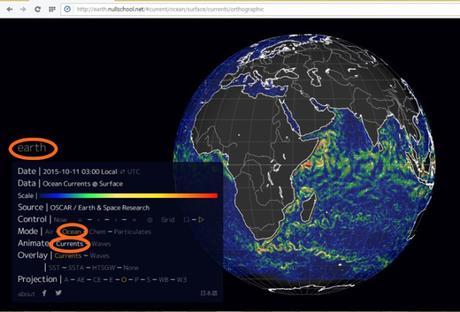
The animated globe is a good way to internalize the big picture of weather events and patterns. Ocean current data is based on the same OSCAR model you can request by email.
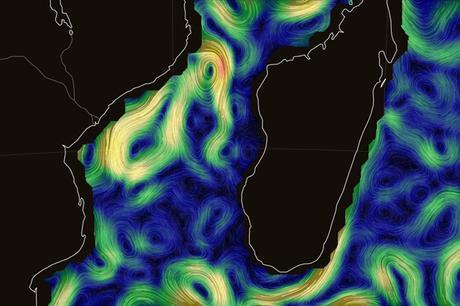
It was looking at this beautiful data visualization that first really impressed on me how “the current” everyone talks about in the Mozambique channel, how important it is to avoid wind vs current in our North to South path, isn’t some kind of monolithic uni-directional force. It is a complicated swirling mass that moves east and west as much as it moves north and south.
What’s critical to know, however, is that the current data used for this model is only updated weekly, so it’s really only a big-picture guide and not a true weather tool. Maybe this is why the boat mentioning they had checked earth.nullschool just before departure is puzzled that they’re finding different conditions than what the site showed.
Watch us get nailed
Well, hopefully we don’t get nailed, and manage to skirt the worst of the current along the route from here to Richards Bay. Routing here requires tough decisions. In the last few weeks, we’ve changed our channel crossing strategy four or five times as we learn more, read more, and shape an opinion. But we don’t have the hubris to imagine we can have perfect information or be the experts. We’ll keep absorbing information until we go and try to make smart decisions along the way. We update our routes on PredictWind as our passages progress, so that changes in weather (and the more accurate, nearer forecast) can be taken into account and we can adapt our route as needed.
Tracking Totem underway
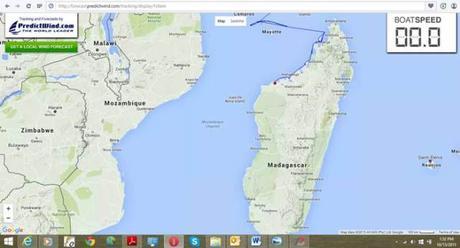
Our position (and speed, if we’re underway) is updated hourly on Totem’s PredictWind tracking page at forecast.predictwind.com/tracking/display/Totem
We also post a position to Farkwar about every 24 hours; it’s viewable anytime at www.farkwar.com/boats/totem or the map at the bottom of this page. You can sign up to ‘follow’ us there, or see the updates as they happen on our Twitter stream or Facebook page.
This post is syndicated by Sailfeed. Clicking through puts a tip in our cruising kitty: thank you!

